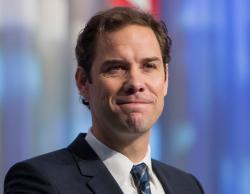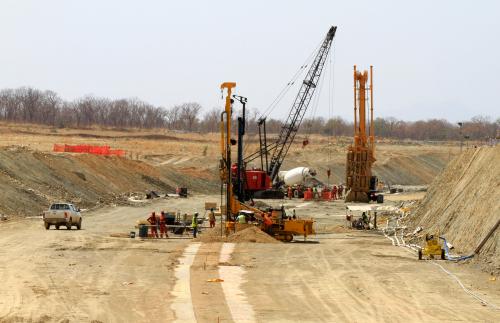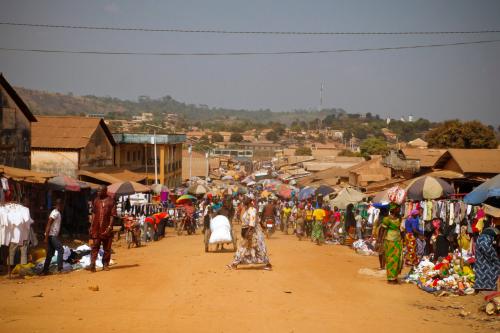This brief distills key issues for policy deliberations related to the mobilizing private financing for the Sustainable Development Goals (SDGs). It will be discussed on September 21 in New York at a high-level UN panel on “Accelerating capital flows and investments in the SDGs.”
Sustainable finance: Imagining realignment
The ambitious goals of Agenda 2030 and the Paris Agreement on climate change have not yet been matched by an equally ambitious financing plan that will get the right resources to the right places at the right time. Despite articulation of a global financing framework in the U.N.’s 2015 Addis Ababa Action Agenda, both public and private financing for sustainable development are underperforming relative to expectations and needs.
Public resources command attention because they can be programmed by government commitments with some degree of confidence on a multi-year basis. Publicly-funded investments can also incorporate non-market environmental, social and governance issues into project design, selection and implementation. It is certainly the case that many countries still need to mobilize more domestic public resources for the SDGs and climate action. There are, however, well-understood limits to public financing, including pressures on official development assistance (ODA) due to diversion of resources to humanitarian relief and to economic strains in major donor economies, many of which have roots in the most recent global financial crisis.
Private finance, the focus of this policy brief, is also indispensable for sustainable development. It is more plentiful than public finance, but operates independently of intergovernmental processes and responds instead to real-time market signals, guided by the need to maximize expected return within existing policy and regulatory frameworks. Mobilizing and orienting private finance frames one of the most important SDG challenges: shaping the risks, returns, and other incentives facing market actors to ensure private financing supports achievement of the Goals. This is the challenge of “sustainable finance,” a term we use to define financial flows—public or private—that are allocated in a way that simultaneously promotes sustainable development, including its economic, social and environmental imperatives. Sustainable finance can be induced through norms and standards, institutional processes, market forces, market regulations, policy incentives, benchmarking, peer pressure, citizen advocacy, and other means.
Many important activities are already underway to help promote sustainable finance around the world. For example:
- The Principles for Responsible Investment advance environmental, social, and governance (ESG) standards for investment processes across 1,500 corporate signatories with more than $60 trillion in assets under management.
- The U.N. Global Compact has been helping companies, investors and stock exchanges to integrate ESG issues into their business practices, including through the launch of the Global Compact 100 index of responsible companies.
- The G-20 welcomed, at its 2015 leaders’ summit in China, options put forward by its Green Finance Study Group to develop voluntary proposals for scaling up green finance.
- The Financial Stability Board’s Task Force on Climate-related Financial Disclosures, chaired by Michael Bloomberg, is developing disclosure guidelines to provide a common reference point for companies, investors, lenders, insurers and other stakeholders.
- The Global Reporting Initiative promotes sustainability disclosures for companies around the world.
- The Equator Principles offer an approach for more than 80 financial institutions to manage and assess risk in project finance, corporate lending, and advisory services.
- The Sustainable Stock Exchanges initiative offers a peer learning platform for 48 exchanges from 52 countries to advance ESG reporting among listed companies.
- The UNEP Finance Initiative has partnered with the private sector since 1992; more recently the Inquiry into the Design of a Sustainable Financial System has mapped actions for accelerating the financial system’s transition to support a green economy.
- A European Union Directive on the Disclosure of Non-Financial and Diversity Information requires ESG disclosures by large companies and groups, beginning in 2017.
- The Sustainability Accounting Standards Board has issued provisional sustainability accounting standards for 79 industries, aiming to inform the future work of the U.S. Securities and Exchange Commission.
- The International Integrated Reporting Council is testing a framework to align capital allocation and corporate activities with broader objectives of financial stability and sustainable development.
- CDP (formerly Carbon Disclosure Project) works with more than 800 investors to help identify environmental risks embedded in their portfolios.
- The Carbon Pricing Leadership Coalition convenes more than 100 major companies and other stakeholders to advance global carbon pricing efforts.
- The Portfolio Decarbonization Coalition convenes 25 major investors overseeing the gradual decarbonization of $600 billion in assets under management.
- The Business and Sustainable Development Commission has been launched with leadership from companies like Alibaba, Merck, Safaricom, Temasek, and Unilever to identify a business case for the SDGs.
- Focusing Capital on the Long Term has been launched to discourage market short-termism and instead encourage behaviors focused on longer-term economic progress across generations.
- The International Development Finance Club has established a set of guidelines for tracking the volume of climate mitigation and adaptation activities mobilized by long-term national and international financial institutions.
- The International Standards Organization has developed guidance on measuring an organization’s contribution to sustainable development (ISO 26000) and has drafted guidance for public consultation on measuring the sustainability of corporate procurement (ISO 20400).
These initiatives are contributing to progress. For instance, green bonds were first launched only a few years ago and are already likely to exceed $75 billion in 2016. Impact investments topped $15 billion in 2015. Individual firms like the insurer Aviva have issued calls for action to mobilize finance for the SDGs, based on detailed analysis. The range of activities underway suggests that markets may be close to a tipping point. But it also highlights the scattered nature of individual initiatives and the long path to creating new financing norms. There is a long way to go to scale up sustainable finance to desired levels.
One central problem is the ambiguity of current systems. Consider, for example, green finance. The core idea is to create reporting standards that ensure funds will be invested in low-carbon emission activities. But it’s not yet clear exactly how “green” should be defined. Equally importantly, how do environmental standards relate to other economic and social sustainability imperatives? What if, for example, a green bond finances a low-carbon energy project that leaves toxins in local ecosystems or uses inputs produced by indentured child labor?
It is intuitive to think of “sustainable finance” as financing that is consistent with achieving all 17 SDGs. Because all governments have endorsed the SDGs, there is a prima facie presumption that public finance should be “sustainable”, but in practice this may not always be the case. An understanding of whether public or private finance is “sustainable” requires a multi-dimensional set of metrics that can help roll out the early successes of climate finance across all SDG-relevant sectors. In other words, if each SDG were represented by its own color, then green finance needs to be expanded to include all elements of the rainbow – capturing priorities (and addressing tradeoffs) across issues ranging from sustainable food systems, to healthy living, to gender equality in the workforce, to sustainable marine life in the oceans. Investors, companies, policymakers and civil society all require a common approach to quantifiable operational standards that align with the priorities.
Download the full report »
The Brookings Institution is committed to quality, independence, and impact.
We are supported by a diverse array of funders. In line with our values and policies, each Brookings publication represents the sole views of its author(s).








